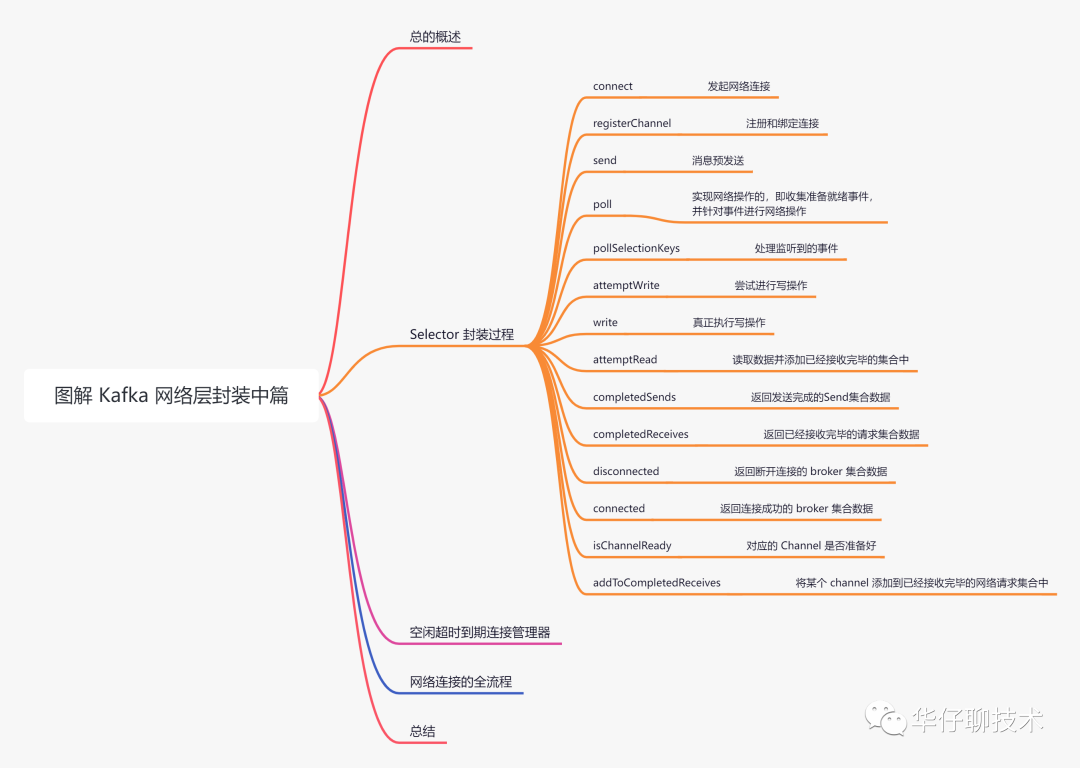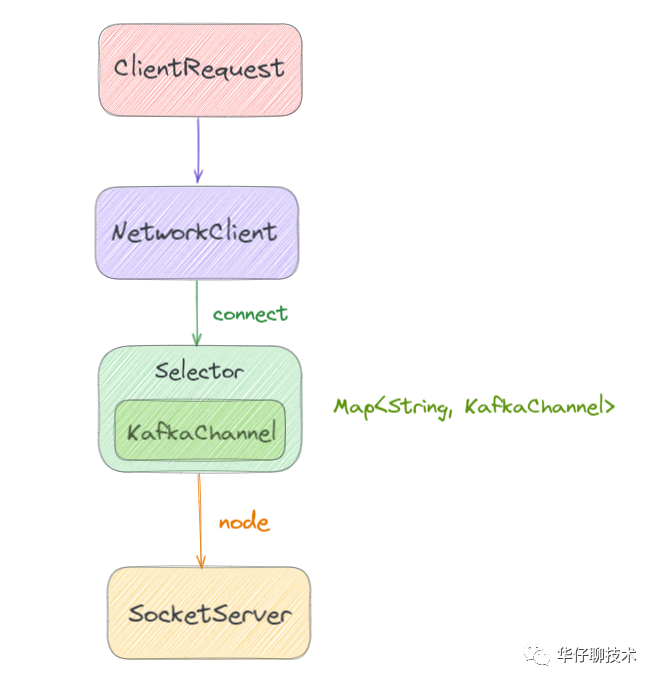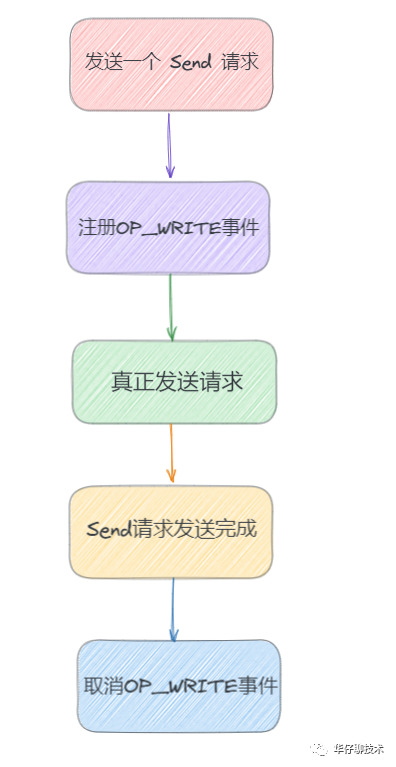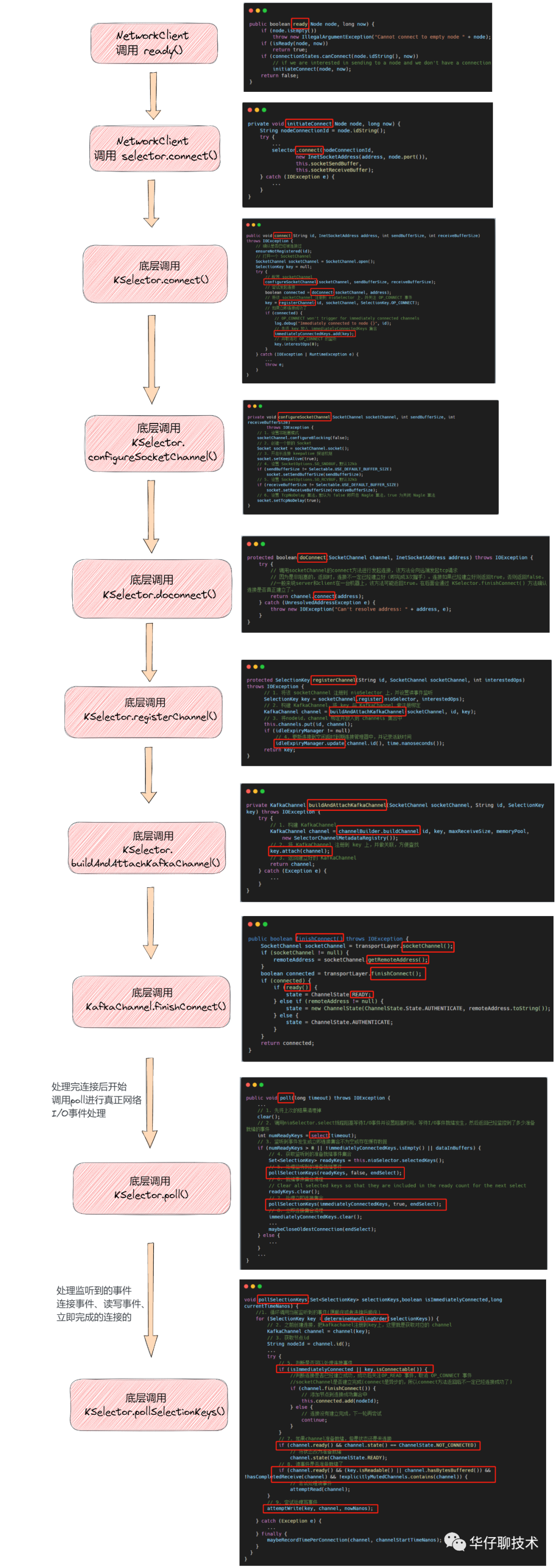
大家好,我是 华仔, 又跟大家见面了。
在上一篇中,主要带大家深度剖析了「Kafka 对 NIO SocketChannel、Buffer」的封装全过程,今天我们接着聊聊 Kafka 是如何封装 Selector 多路复用器的,本系列总共分为3篇,今天是中篇,主要剖析4、5两个问题:
- 针对 Java NIO 的 SocketChannel,kafka 是如何封装统一的传输层来实现最基础的网络连接以及读写操作的?
- 剖析 KafkaChannel 是如何对传输层、读写 buffer 操作进行封装的?
- 剖析工业级 NIO 实战:如何基于位运算来控制事件的监听以及拆包、粘包是如何实现的?
- 剖析 Kafka 是如何封装 Selector 多路复用器的?
- 剖析 Kafka 封装的 Selector 是如何初始化并与 Broker 进行连接以及网络读写的?
- 剖析 Kafka 网络发送消息和接收响应的整个过程是怎样的?
认真读完这篇文章,我相信你会对 Kafka 封装 Java NIO 源码有更加深刻的理解。
这篇文章干货很多,希望你可以耐心读完。

一、总体概述
大家都知道在 Java NIO 有个三剑客,即「SocketChannel通道」、「Buffer读写」、「Selector多路复用器」,上篇已经讲解了前2个角色,今天我们来聊聊最后一个重要的角色。
Kafka Selector 是对 Java NIO Selector 的二次封装,主要功能如下:
- 提供网络连接以及读写操作
- 对准备好的事件进行收集并进行网络操作
为了方便大家理解,所有的源码只保留骨干。
二、Selector 封装过程
github 源码地址如下:
https://github.com/apache/kafka/blob/2.7/clients/src/main/java/org/apache/kafka/common/network/Selector.java。
org.apache.kafka.common.network.Selector,该类是 Kafka 网络层最重要最核心的实现,也是非常经典的工业级通信框架实现,为了简化,这里称为 Kselector, 接下来我们先来看看该类的重要属性字段:
public class Selector implements Selectable, AutoCloseable {
// 在 Java NIO 中用来监听网络I/O事件
private final java.nio.channels.Selector nioSelector;
// channels 管理
private final Map<String, KafkaChannel> channels;
// 发送完成的Send集合
private final List<Send> completedSends;
// 已经接收完毕的请求集合
private final LinkedHashMap<String, NetworkReceive> completedReceives;
// 立即连接的集合
private final Set<SelectionKey> immediatelyConnectedKeys;
// 关闭连接的 channel 集合
private final Map<String, KafkaChannel> closingChannels;
// 断开连接的节点集合
private final Map<String, ChannelState> disconnected;
// 连接成功的节点集合
private final List<String> connected;
// 发送失败的请求集合
private final List<String> failedSends;
// 用来构建 KafkaChannel 的工具类
private final ChannelBuilder channelBuilder;
// 最大可以接收的数据量大小
private final int maxReceiveSize;
// 空闲超时到期连接管理器
private final IdleExpiryManager idleExpiryManager;
// 用来管理 ByteBuffer 的内存池
private final MemoryPool memoryPool;
// 初始化 Selector
public Selector(int maxReceiveSize,
long connectionMaxIdleMs,
int failedAuthenticationDelayMs,
Metrics metrics,
Time time,
String metricGrpPrefix,
Map<String, String> metricTags,
boolean metricsPerConnection,
boolean recordTimePerConnection,
ChannelBuilder channelBuilder,
MemoryPool memoryPool,
LogContext logContext) {
try {
this.nioSelector = java.nio.channels.Selector.open();
} catch (IOException e) {
throw new KafkaException(e);
}
this.maxReceiveSize = maxReceiveSize;
this.time = time;
this.channels = new HashMap<>();
this.explicitlyMutedChannels = new HashSet<>();
this.outOfMemory = false;
this.completedSends = new ArrayList<>();
this.completedReceives = new LinkedHashMap<>();
this.immediatelyConnectedKeys = new HashSet<>();
this.closingChannels = new HashMap<>();
this.keysWithBufferedRead = new HashSet<>();
this.connected = new ArrayList<>();
this.disconnected = new HashMap<>();
this.failedSends = new ArrayList<>();
this.log = logContext.logger(Selector.class);
this.sensors = new SelectorMetrics(metrics, metricGrpPrefix, metricTags, metricsPerConnection);
this.channelBuilder = channelBuilder;
this.recordTimePerConnection = recordTimePerConnection;
this.idleExpiryManager = connectionMaxIdleMs < 0 ? null : new IdleExpiryManager(time, connectionMaxIdleMs);
this.memoryPool = memoryPool;
this.lowMemThreshold = (long) (0.1 * this.memoryPool.size());
this.failedAuthenticationDelayMs = failedAuthenticationDelayMs;
this.delayedClosingChannels = (failedAuthenticationDelayMs > NO_FAILED_AUTHENTICATION_DELAY) ? new LinkedHashMap<String, DelayedAuthenticationFailureClose>() : null;
}
}
重要字段如下所示:
- nioSelector:在 Java NIO 中用来监听网络I/O事件。
- channels:用来进行管理客户端到各个Node节点的网络连接,Map 集合类型 <Node节点id, KafkaChannel>
- completedSends:已经发送完成的请求对象 Send 集合,List 集合类型。
- completedReceives:已经接收完毕的网络请求集合,LinkedHashMap 集合类型 <ChannelId, NetworkReceive>,其中 value 都是已经接收完毕的 NetworkReceive 类对象。
- immediatelyConnectedKeys:立即连接key集合。
- closingChannels:关闭连接的 channel 集合。
- disconnected:断开连接的集合。Map 集合类型 <ChannelId, ChannelState>,value 是 KafkaChannel 的状态,可以在使用的时候可以通过这个 ChannelState 状态来判断处理逻辑。
- connected:成功连接的集合,List 集合类型,存储成功请求的 ChannelId。
- failedSends:发送失败的请求集合,List 集合类型, 存储失败请求的 ChannelId。
- channelBuilder:用来构建 KafkaChannel 的工具类。
- maxReceiveSize:最大可以接收的数据量大小。
- idleExpiryManager:空闲超时到期连接管理器。
- memoryPool:用来管理 ByteBuffer 的内存池,分配以及回收。
介绍完字段后,我们来看看该类的方法。方法比较多,这里深度剖析下其中几个重要方法,通过学习这些方法的不仅可以复习下 Java NIO 底层组件,另外还可以学到 Kafka 封装这些底层组件的实现思想。
NetworkClient 的请求一般都是交给 Kselector 去处理并完成的。而 Kselector 使用 NIO 异步非阻塞模式负责具体的连接、读写事件等操作。
我们先看下连接过程,客户端在和节点连接的时候,会创建和服务端的 SocketChannel 连接通道。Kselector 维护了每个目标节点对应的 KafkaChannel。
如下图所示:

1、connect()
public void connect(String id, InetSocketAddress address, int sendBufferSize, int receiveBufferSize) throws IOException {
// 1.先确认是否已经被连接过
ensureNotRegistered(id);
// 2.打开一个 SocketChannel
SocketChannel socketChannel = SocketChannel.open();
SelectionKey key = null;
try {
// 3.设置 socketChannel 信息
configureSocketChannel(socketChannel, sendBufferSize, receiveBufferSize);
// 4.尝试发起连接
boolean connected = doConnect(socketChannel, address);
// 5. 将该 socketChannel 注册到 nioSelector 上,并关注 OP_CONNECT 事件
key = registerChannel(id, socketChannel, SelectionKey.OP_CONNECT);
// 6.如果立即连接成功了
if (connected) {
...
// 先将 key 放入 immediatelyConnectedKeys 集合
immediatelyConnectedKeys.add(key);
// 并取消对 OP_CONNECT 的监听
key.interestOps(0);
}
} catch (IOException | RuntimeException e) {
if (key != null)
immediatelyConnectedKeys.remove(key);
channels.remove(id);
socketChannel.close();
throw e;
}
}
// 设置 socketChannel 信息
private void configureSocketChannel(SocketChannel socketChannel, int sendBufferSize, int receiveBufferSize) throws IOException {
// 1. 设置非阻塞模式
socketChannel.configureBlocking(false);
// 2. 创建一个新的 Socket
Socket socket = socketChannel.socket();
// 3. 开启长连接 keepalive 探活机制
socket.setKeepAlive(true);
// 4. 设置 SocketOptions.SO_SNDBUF,默认12kb
if (sendBufferSize != Selectable.USE_DEFAULT_BUFFER_SIZE)
socket.setSendBufferSize(sendBufferSize);
// 5. 设置 SocketOptions.SO_RCVBUF,默认32kb
if (receiveBufferSize != Selectable.USE_DEFAULT_BUFFER_SIZE)
socket.setReceiveBufferSize(receiveBufferSize);
// 6. 设置 TcpNoDelay 算法,默认为 false 即开启 Nagle 算法,true 为关闭 Nagle 算法
socket.setTcpNoDelay(true);
}
// 发起连接
protected boolean doConnect(SocketChannel channel, InetSocketAddress address) throws IOException {
try {
// 调用socketChannel的connect方法进行发起连接,该方法会向远端发起tcp请求
// 因为是非阻塞的,返回时,连接不一定已经建立好(即完成3次握手)。连接如果已经建立好则返回true,否则返回false。
//一般来说server和client在一台机器上,该方法可能返回true。在后面会通过 KSelector.finishConnect() 方法确认连接是否真正建立了。
return channel.connect(address);
} catch (UnresolvedAddressException e) {
throw new IOException("Can't resolve address: " + address, e);
}
}
该方法主要是用来发起网络连接,连接过程大致分为如下六步:
- 先确认是否已经被连接过,即是否已经存在于连接成功集合或正在关闭连接的集合里,如果存在说明连接已经存在或者关闭了,就不应再次发起连接。
- 打开一个 SocketChannel,创建一个连接。
- 设置 SocketChannel 信息。其中包括设置「非阻塞模式」、「长链接探活机制」、「SocketOptions.SO_SNDBUF 大小」、「SocketOptions.SO_RCVBUF 大小」、「关闭 Nagle 算法」等,其中 SO_SNDBUF、SO_RCVBUF 表示内核发送和接收数据缓存的大小。
- 尝试发起连接,由于是设置为非阻塞,调用完方法会直接返回,「此时连接不一定已经建立了」。当然也可能立即就连接上了,如果立即连接上返回值为true,没立即连接上返回值为false。
- 将该 socketChannel 注册到 nioSelector 上,并关注 OP_CONNECT 事件,如果上一步没立即连接上,还需要继续监听 OP_CONNECT 事件,等连接上了再做处理。
- 如果立即连接成功了,先将 key 放入 immediatelyConnectedKeys 集合,然后取消对 OP_CONNECT 的监听。此时已经连接成功了就没必要在监听 OP_CONNECT 事件了。
这里需要注意下: 因为是非阻塞方式,所以 channel.connect() 发起连接,「可能在正式建立连接前就返回了」,为了确定连接是否建立,需要再调用 「finishConnect」 确认完全连接上了。
2、registerChannel()
// 将该 socketChannel 注册到 nioSelector 上,并关注感兴趣的事件
protected SelectionKey registerChannel(String id, SocketChannel socketChannel, int interestedOps) throws IOException {
// 1. 将该 socketChannel 注册到 nioSelector 上,并设置读事件监听
SelectionKey key = socketChannel.register(nioSelector, interestedOps);
// 2. 构建 KafkaChannel,将 key 与 KafkaChannel 做注册绑定
KafkaChannel channel = buildAndAttachKafkaChannel(socketChannel, id, key);
// 3. 将nodeid,channel 绑定并放入到 channels 集合中
this.channels.put(id, channel);
if (idleExpiryManager != null)
// 4. 更新连接到空闲超时到期连接管理器中,并记录活跃时间
idleExpiryManager.update(channel.id(), time.nanoseconds());
return key;
}
// 构建 KafkaChannel 并关联 key 和 Channel,方便查找
private KafkaChannel buildAndAttachKafkaChannel(SocketChannel socketChannel, String id, SelectionKey key) throws IOException {
try {
// 1. 构建 KafkaChannel
KafkaChannel channel = channelBuilder.buildChannel(id, key, maxReceiveSize, memoryPool,
new SelectorChannelMetadataRegistry());
// 2. 将 KafkaChannel 注册到 key 上,并做关联,方便查找
key.attach(channel);
// 3. 返回建立好的 KafkaChannel
return channel;
} catch (Exception e) {
try {
socketChannel.close();
} finally {
key.cancel();
}
throw new IOException("Channel could not be created for socket " + socketChannel, e);
}
}
该方法主要用来注册和绑定连接的,过程如下:
- 将该 socketChannel 注册到 nioSelector 上,并设置读事件监听。
- 构建 KafkaChannel,以及将 key 与 KafkaChannel 做关联绑定,方便查找,既可以通过 key 找到 channel,也可以通过 channel 找到 key。
讲解完建立连接后,我们来看看消息发送的相关方法。
KSelector.send() 方法是将之前创建的 RequestSend 对象先缓存到 KafkaChannel 的 send 字段中,并关注此连接的 OP_WRITE 事件,并没有真正发生网络 I/O 操作。会在下次调用 KSelector.poll() 时,才会将 RequestSend 对象发送出去。
如果此 KafkaChannel 的 send 字段上还保存着一个未完全发送成功的 RequestSend 请求,为了防止覆盖,会抛出异常。每个 KafkaChannel 一次 poll 过程中只能发送一个 Send 请求。
客户端的请求 Send 会被设置到 KafkaChannel 中,KafkaChannel 的 TransportLayer 会为 SelectionKey 注册 OP_WRITE 事件。
此时 Channel 的 SelectionKey 就有了 OP_CONNECT、OP_WRITE 事件,在 Kselector 的轮询过程中当发现这些事件准备就绪后,就开始执行真正的操作。
基本流程就是:

3、send()
/**
* 消息预发送
*/
public void send(Send send) {
// 1. 从服务端获取 connectionId
String connectionId = send.destination();
// 2. 从数据包中获取对应连接
KafkaChannel channel = openOrClosingChannelOrFail(connectionId);
// 3. 如果关闭连接集合中存在该连接
if (closingChannels.containsKey(connectionId)) {
// 把 connectionId 放入 failedSends 集合里
this.failedSends.add(connectionId);
} else {
try {
// 4. 暂存数据预发送,并没有真正的发送,一次只能发送一个
channel.setSend(send);
} catch (Exception e) {
// 5. 更新 KafkaChannel 的状态为发送失败
channel.state(ChannelState.FAILED_SEND);
// 6. 把 connectionId 放入 failedSends 集合里
this.failedSends.add(connectionId);
// 7. 关闭连接
close(channel, CloseMode.DISCARD_NO_NOTIFY);
...
}
}
}
// 判断 channelid 是否存在
private KafkaChannel openOrClosingChannelOrFail(String id) {
// 通过 channelid 先从 channels 集合中获取
KafkaChannel channel = this.channels.get(id);
// 如果为空那么再从 closingChannels 集合中获取
if (channel == null)
channel = this.closingChannels.get(id);
// 如果还为空则抛异常
if (channel == null)
throw new IllegalStateException("Attempt to retrieve channel for which there is no connection. Connection id " + id + " existing connections " + channels.keySet());
return channel;
}
该方法主要用来消息预发送,即在发送的时候把消息线暂存在 KafkaChannel 的 send 字段里,然后等着 poll() 执行真正的发送,过程如下:
- 从服务端获取 connectionId。
- 从 channels 或 closingChannels 集合中找对应的 KafkaChannel,如果都为空就抛异常。
- 如果关闭连接 closingChannels 集合中存在该连接,说明连接还没有被建立,则把连接放到发送失败 failedSends 的集合中。
- 否则即是连接建立成功,「就把要发送的数据先保存在 send 字段里暂存起来,等待后续 poll() 去调用真正的发送」。
- 如果暂存异常后,则更新 KafkaChannel 的状态为发送失败。
- 把 connectionId 放入 failedSends 集合里。
- 最后关闭连接。
讲完消息预发送,接下来我们来看看最核心的 poll 和 pollSelectionKeys 方法。
在 Kselector 的轮询中可以操作连接事件、读写事件等,是真正执行网络I/O事件操作的地方,它会调用 nioSelector.select() 方法等待 I/O 事件就绪。
当 Channel 可写时,发送 KafkaChannel.send 字段,「一次最多只发送一个 RequestSend,有时候一个 RequestSend 也发送不完,需要多次 poll 才能发送完成」。
当 Channel 可读时,读取数据到 KafkaChannel.receive,「当读取一个完整的 NetworkReceive ,并在一次 pollSelectionKeys() 完成后会将 NetworkReceive 中的数据转移到 completedReceives 集合中」。
最后调用 maybeCloseOldestConnection() 方法,根据 lruConnections 记录,设置 channel 状态为过期,并关闭长期空闲的连接。
4、poll()
public void poll(long timeout) throws IOException {
...
// 1. 先将上次的结果清理掉
clear();
boolean dataInBuffers = !keysWithBufferedRead.isEmpty();
...
/* check ready keys */
long startSelect = time.nanoseconds();
// 2. 调用nioSelector.select线程阻塞等待I/O事件并设置阻塞时间,等待I/O事件就绪发生,然后返回已经监控到了多少准备就绪的事件
int numReadyKeys = select(timeout);
long endSelect = time.nanoseconds();
// 记录耗时
this.sensors.selectTime.record(endSelect - startSelect, time.milliseconds());
// 3. 监听到事件发生或立即连接集合不为空或存在缓存数据
if (numReadyKeys > 0 || !immediatelyConnectedKeys.isEmpty() || dataInBuffers) {
// 4. 获取监听到的准备就绪事件集合
Set<SelectionKey> readyKeys = this.nioSelector.selectedKeys();
// 在SSL连接才可能会存在缓存数据
if (dataInBuffers) {
// 清除所有的就绪事件
keysWithBufferedRead.removeAll(readyKeys); //so no channel gets polled twice
Set<SelectionKey> toPoll = keysWithBufferedRead;
// 重新初始化
keysWithBufferedRead = new HashSet<>(); //poll() calls will repopulate if needed
// 处理事件
pollSelectionKeys(toPoll, false, endSelect);
}
// 5. 处理监听到的准备就绪事件
pollSelectionKeys(readyKeys, false, endSelect);
// 6. 就绪事件集合清理
// Clear all selected keys so that they are included in the ready count for the next select
readyKeys.clear();
// 7. 处理立即连接集合
pollSelectionKeys(immediatelyConnectedKeys, true, endSelect);
// 8. 立即连接集合清理
immediatelyConnectedKeys.clear();
...
maybeCloseOldestConnection(endSelect);
} else {
...
}
...
}
// 调用nioselector.select进行阻塞监听就绪事件
private int select(long timeoutMs) throws IOException {
if (timeoutMs < 0L)
throw new IllegalArgumentException("timeout should be >= 0");
if (timeoutMs == 0L)
return this.nioSelector.selectNow();
else
return this.nioSelector.select(timeoutMs);
}
该方法主要用来实现网络操作的,即收集准备就绪事件,并针对事件进行网络操作,具体的过程如下:
- 上来先将上次的结果清理掉,大概包括「completedSends」、「connected」、「disconnected」、「failedSends」、「completedReceives」、「请求发送或者接受完毕关闭通道」、「记录失败状态到disconnected」等。
- 调用nioSelector.select线程阻塞等待I/O事件并设置阻塞时间,等待I/O事件就绪发生,然后返回已经监控到了多少准备就绪的事件。
- 判断是否可以处理网络事件,三个条件满足其一就可以处理:「监听到事件发生」、「立即连接集合不为空」、「存在缓存数据」,其中最后一个是在加密SSL连接才可能有的。
- 获取监听到的准备就绪事件集合。
- 调用 pollSelectionKeys() 处理监听到的准备就绪的事件集合,包括「连接事件」、「网络读写事件」。其中读完的请求放入 completedReceives 集合,写完的响应放入 completedSends 集合,连接成功的放入 connected集合,断开的连接放入 disconnected 集合等。
- 清除所有选定的键,以便它们包含在下一次选择的就绪计数中。
- 调用 pollSelectionKeys() 处理立即连接集合。「这个集合的元素都是一开始做连接就立即连接上的,等待被处理」。
- 立即连接集合清理。
5、pollSelectionKeys()
void pollSelectionKeys(Set<SelectionKey> selectionKeys,boolean isImmediatelyConnected,long currentTimeNanos) {
//1. 循环调用当前监听到的事件(原顺序或者洗牌后顺序)
for (SelectionKey key : determineHandlingOrder(selectionKeys)) {
// 2. 之前创建连接,把kafkachanel注册到key上,这里就是获取对应的 channel
KafkaChannel channel = channel(key);
...
boolean sendFailed = false;
// 3. 获取节点id
String nodeId = channel.id();
...
// 4. 更新连接到空闲超时到期连接管理器中,并记录活跃时间
if (idleExpiryManager != null)
idleExpiryManager.update(nodeId, currentTimeNanos);
try {
// 5. 判断是否可以处理连接事件
if (isImmediatelyConnected || key.isConnectable()) {
//判断连接是否已经建立成功,成功后关注OP_READ 事件,取消 OP_CONNECT 事件
//socketChannel是否建立完成(connect是异步的,所以connect方法返回后不一定已经连接成功了)
if (channel.finishConnect()) {
// 添加节点到连接成功集合中
this.connected.add(nodeId);
...
// 获取 socketChannel
SocketChannel socketChannel = (SocketChannel) key.channel();
...
} else {
// 连接没有建立完成,下一轮再尝试
continue;
}
}
// 6. 如果没有准备就绪就开始准备,即处理 tcp 连接还未完成的连接,进行传输层的握手及认证
if (channel.isConnected() && !channel.ready()) {
// 进行连接准备并进行身份验证
channel.prepare();
if (channel.ready()) {
...
// 准备好后记录 Metrics 信息
}
}
// 7. 如果channel准备就绪,但是状态还是未连接
if (channel.ready() && channel.state() == ChannelState.NOT_CONNECTED)
// 将状态改为准备就绪
channel.state(ChannelState.READY);
...
// 8. 读事件是否准备就绪了
if (channel.ready() && (key.isReadable() || channel.hasBytesBuffered()) && !hasCompletedReceive(channel) && !explicitlyMutedChannels.contains(channel)) {
// 尝试处理读事件
attemptRead(channel);
}
...
try {
// 9. 尝试处理写事件
attemptWrite(key, channel, nowNanos);
} catch (Exception e) {
sendFailed = true;
throw e;
}
/* cancel any defunct sockets */
if (!key.isValid())
// 10.如果连接失效,关闭连接
close(channel, CloseMode.GRACEFUL);
} catch (Exception e) {
...
} finally {
maybeRecordTimePerConnection(channel, channelStartTimeNanos);
}
}
}
// 当内存不足时会对selectorKey进行洗牌
private Collection<SelectionKey> determineHandlingOrder(Set<SelectionKey> selectionKeys) {
if (!outOfMemory && memoryPool.availableMemory() < lowMemThreshold) {
List<SelectionKey> shuffledKeys = new ArrayList<>(selectionKeys);
// 洗牌
Collections.shuffle(shuffledKeys);
return shuffledKeys;
} else {
return selectionKeys;
}
}
// kafkaChannel类方法,判断连接是否已经建立完成
public boolean finishConnect() throws IOException {
SocketChannel socketChannel = transportLayer.socketChannel();
if (socketChannel != null) {
remoteAddress = socketChannel.getRemoteAddress();
}
boolean connected = transportLayer.finishConnect();
if (connected) {
if (ready()) {
state = ChannelState.READY;
} else if (remoteAddress != null) {
state = new ChannelState(ChannelState.State.AUTHENTICATE, remoteAddress.toString());
} else {
state = ChannelState.AUTHENTICATE;
}
}
return connected;
}
// kafkaChannel类方法,连接准备
public void prepare() throws AuthenticationException, IOException {
boolean authenticating = false;
try {
// 通过没有ready
if (!transportLayer.ready())
// 进行握手操作
transportLayer.handshake();
// 已经ready 但是没有认证
if (transportLayer.ready() && !authenticator.complete()) {
// 开启认证中标识
authenticating = true;
// 开始认证
authenticator.authenticate();
}
} catch (AuthenticationException e) {
...
throw e;
}
// 准备好以后
if (ready()) {
// 计算认证成功数
++successfulAuthentications;
// 状态改为ready
state = ChannelState.READY;
}
}
// kafkaChannel类方法,判断 channel 是否就绪
public boolean ready() {
return transportLayer.ready() && authenticator.complete();
}
// kafkaChannel类方法,判断 channel 是否有缓存数据
public boolean hasBytesBuffered() {
return transportLayer.hasBytesBuffered();
}
//PlaintextTransportLayer 方法,明文传输永远返回true
public boolean ready() {
return true;
}
//PlaintextTransportLayer 方法,明文传输永远返回true
public boolean hasBytesBuffered() {
return false;
}
该方法是用来处理监听到的事件,包括连接事件、读写事件、以及立即完成的连接的。具体过程如下:
- 循环调用当前监听到的事件「连接事件」、(原顺序或者内存不足时洗牌后顺序)。
- 获取对应的 channel。
- 从 channel 中获取节点id。
- 如果空闲超时到期连接管理器不为空,则更新连接到空闲超时到期连接管理器中,并记录活跃时间。
- 判断是否可以处理连接事件,有两个判断条件:「立即连接完成 isImmediatelyConnected」、「连接事件准备好 key.isConnectable」。满足其一就要处理连接事件了。
- 调用 finishConnect 方法判断连接是否已经建立完成,如果连接成功了,就关注「OP_READ 事件」、取消 「OP_CONNECT 事件」,然后做好接收数据的准备。
- 如果连接没有建立完成,那么下一轮再尝试。
- 如果没有准备就绪就处理 tcp 连接还未完成的连接,并进行传输层的握手以及身份认证,最后返回连接ready,准备好后记录 Metrics 信息。
- 如果channel准备就绪,但是状态还是未连接,修改状态为ready 准备就绪。
- 判断读事件操作是否准备就绪了。此时要「同时满足4个条件」才算读操作准备就绪了,然后尝试处理读事件:
- 「channel已经准备就绪」,这里对于明文连接都是true,所以我们不用关心。
- 「读事件已经就绪或者 channel 中有缓存数据」,而 channel 里有缓存数据对于明文传输连接永远是 false,也不用关心
- 「NetworkReceive 对象没有被读完」还要继续读。
- 「加锁 channels 集合中不存在该channel」,服务端用来处理消息重复的。
- 尝试处理写事件。
- 最后如果如果连接失效,则关闭连接。
讲解完最核心的 poll() 和 pollSelectionKeys() 方法后,我们来看看「网络读写事件」的处理过程。
6、attemptWrite()
private void attemptWrite(SelectionKey key, KafkaChannel channel, long nowNanos) throws IOException {
//
if (channel.hasSend()
&& channel.ready()
&& key.isWritable()
&& !channel.maybeBeginClientReauthentication(() -> nowNanos)) {
// 进行写操作
write(channel);
}
}
该方法用来判断尝试进行写操作,方法很简单,必须「同时满足4个条件」:
- 「还有数据可以发送」
- 「channel 连接就绪」
- 「写事件是可写状态」
- 「客户端验证没有开启」
当满足以上4个条件后就可以进行写操作了,接下来我们看看写操作的过程。
7、write()
// 执行写操作
void write(KafkaChannel channel) throws IOException {
// 1.获取 channel 对应的节点id
String nodeId = channel.id();
// 2. 将保存在 send 上的数据真正发送出去,但是一次不一定能发送完,会返回已经发出的字节数
long bytesSent = channel.write();
// 3. 判断是否发送完成,未完成返回null,等待下次poll继续发送
Send send = channel.maybeCompleteSend();
// 4. 说明已经发出或者发送完成
if (bytesSent > 0 || send != null) {
long currentTimeMs = time.milliseconds();
if (bytesSent > 0)
// 记录发送字节 Metrics 信息
this.sensors.recordBytesSent(nodeId, bytesSent, currentTimeMs);
// 发送完成
if (send != null) {
// 将 send 添加到 completedSends
this.completedSends.add(send);
// 记录发送完成 Metrics 信息
this.sensors.recordCompletedSend(nodeId, send.size(), currentTimeMs);
}
}
}
该方法用来真正执行写操作,数据就是上面send()方法被填充的send字段。具体过程如下:
- 获取 channel 对应的节点id。
- 将保存在 send 上的数据真正发送出去,但是「一次不一定能发送完」,会返回已经发出的字节数。
- 判断是否发送完成
- 如果未发送完成返回 null,「等待下次 poll 继续发送」,并继续关注这个 channel 的写事件。
- 如果发送完成,则返回 send,并取消对写事件的关注。
- 发送完成,将 send 添加到 completedSends 集合中。
接下来我们来看看读操作过程。
8、attemptRead()
private void attemptRead(KafkaChannel channel) throws IOException {
// 获取 channel 对应的节点 id
String nodeId = channel.id();
// 将从传输层中读取数据到NetworkReceive对象中
long bytesReceived = channel.read();
if (bytesReceived != 0) {
...
// 判断 NetworkReceive 对象是否已经读完了
NetworkReceive receive = channel.maybeCompleteReceive();
// 当读完后把这个 NetworkReceive 对象添加到已经接收完毕网络请求集合里
if (receive != null) {
addToCompletedReceives(channel, receive, currentTimeMs);
}
}
...
}
// KafkaChannel 方法
public long read() throws IOException {
if (receive == null) {
// 初始化 NetworkReceive 对象
receive = new NetworkReceive(maxReceiveSize, id, memoryPool);
}
// 尝试把 channel 的数据读到 NetworkReceive 对象中
long bytesReceived = receive(this.receive);
...
return bytesReceived;
}
/**
* adds a receive to completed receives
*/
private void addToCompletedReceives(KafkaChannel channel, NetworkReceive networkReceive, long currentTimeMs) {
if (hasCompletedReceive(channel))
throw new IllegalStateException("Attempting to add second completed receive to channel " + channel.id());
// 将 networkReceive 添加到已经接收完毕网络请求集合里
this.completedReceives.put(channel.id(), networkReceive);
...
}
该方法主要用来尝试读取数据并添加已经接收完毕的集合中。
- 先从 channel 中获取节点id。
- 然后调用 channel.read() 方法从传输层中读取数据到 NetworkReceive 对象中。
- 判断本次是否已经读完了即填满了 NetworkReceive 对象,如果没有读完,那么下次触发读事件的时候继续读取填充,如果读取完成后,则将其置为空,下次触发读事件时则创建新的 NetworkReceive 对象。
- 当读完后把这个 NetworkReceive 对象添加到已经接收完毕网络请求集合里。
接下来我们看看几个其他比较简单的方法。
9、completedSends()
public List<Send> completedSends() {
return this.completedSends;
}
该方法主要用来返回发送完成的Send集合数据。
10、completedReceives()
public Collection<NetworkReceive> completedReceives() {
return this.completedReceives.values();
}
该方法主要用来返回已经接收完毕的请求集合数据。
11、disconnected()
public Map<String, ChannelState> disconnected() {
return this.disconnected;
}
该方法主要用来返回断开连接的 broker 集合数据。
12、connected()
public List<String> connected() {
return this.connected;
}
该方法主要用来返回连接成功的 broker 集合数据。
13、isChannelReady()
/**
* check if channel is ready
*/
public boolean isChannelReady(String id) {
// 从 Channels 集合中获取该id对应的 channel
KafkaChannel channel = this.channels.get(id);
// 然后 channel 不为空 则判断是否准备好
return channel != null && channel.ready();
}
// KafkaChannel 类方法
public boolean ready() {
// 判断传输层是否准备好,默认是 PlaintextTransportLayer
return transportLayer.ready() && authenticator.complete();
}
该方法主要用来判断对应的 Channel 是否准备好,参数是 channel id。
14、addToCompletedReceives()
/**
* adds a receive to completed receives
*/
private void addToCompletedReceives(KafkaChannel channel, NetworkReceive networkReceive, long currentTimeMs) {
if (hasCompletedReceive(channel))
throw new IllegalStateException("Attempting to add second completed receive to channel " + channel.id());
// 将 channel id 添加到已经接收完毕的网络请求集合中
this.completedReceives.put(channel.id(), networkReceive);
sensors.recordCompletedReceive(channel.id(), networkReceive.size(), currentTimeMs);
}
/**
* Check if given channel has a completed receive
*/
private boolean hasCompletedReceive(KafkaChannel channel) {
// 判断已经接收完毕的网络集合中是否存在该 channel id
return completedReceives.containsKey(channel.id());
}
该方法主要用来将某个 channel 添加到已经接收完毕的网络请求集合中。
- 先判断该 Channel 对应的 id 是否已经存在于已经接收完毕的网络请求集合中。
- 如果不存在的话再将该 Channel id 添加到已经存在于已经接收完毕的网络请求集合中。
- 记录 Metrics 信息。
三、空闲超时到期连接管理器
为什么会有这个管理器,大家都知道对于 TCP 大量连接或者重连是会对 Kafka 造成性能影响的,而 Kafka 客户端又不能同时连接过多的节点。因此设计这样一个 LRU 算法,每隔9分钟就删除一个空闲过期的连接,以保证已有连接的有效。
private static class IdleExpiryManager {
// lru 连接集合
private final Map<String, Long> lruConnections;
// 连接最大的空闲时间 默认9分钟
private final long connectionsMaxIdleNanos;
private long nextIdleCloseCheckTime;
// 初始化管理器
public IdleExpiryManager(Time time, long connectionsMaxIdleMs) {
this.connectionsMaxIdleNanos = connectionsMaxIdleMs * 1000 * 1000;
// initial capacity and load factor are default, we set them explicitly because we want to set accessOrder = true
// 初始化lru连接集合,设置初始容量,扩容因子,是否排序
this.lruConnections = new LinkedHashMap<>(16, .75F, true);
this.nextIdleCloseCheckTime = time.nanoseconds() + this.connectionsMaxIdleNanos;
}
// 更新活跃时间
public void update(String connectionId, long currentTimeNanos) {
lruConnections.put(connectionId, currentTimeNanos);
}
...
// 删除连接
public void remove(String connectionId) {
lruConnections.remove(connectionId);
}
}
该类通过「LinkedHashMap 结构来实现一个 lru 连接集合」,最核心的方法就是 update() 来更新链接的活跃时间,remove() 来删除连接。
主要用在以下3个地方:
- 在将 channel 注册到 nioSelector 的时候,即调用 registerChannel() 会第一次设置连接的活跃时间。
- 在调用 pollSelectionKeys() 检查到准备就绪的网络事件时,更新连接对应的活跃时间。
- 在调用 close() 关闭连接的时候会从 lru 连接集合中删除该连接。
四、网络连接的全流程
网络连接总共分为以下两个阶段:
- 连接的初始化。
- 完成连接。

五、总结
这里,我们一起来总结一下这篇文章的重点。
1、带你先整体的梳理了 Kafka 对 Java NIO 三剑客中的 Selector 的功能介绍。
2、又带你剖析了 Selector 的重要方法和具体的操作过程。
3、介绍空闲超时到期连接管理器是什么,有什么作用?
4、最后带你梳理了网络连接的全流程。



































